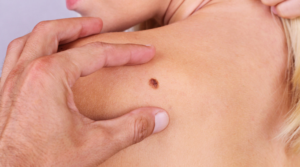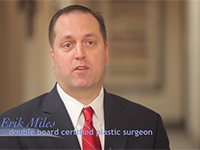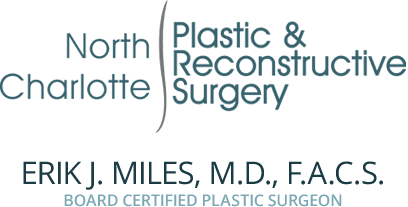Skin cancer removal and reconstruction
Skin cancer surgery Charlotte
It’s summer, and everyone wants to enjoy the sunshine. We love some fun in the sun as much as anyone! However, we have unfortunately also seen the effects of too much sun without enough sunscreen. Besides causing premature aging, it can also lead to skin cancer.
Most types of skin cancer can be treated through surgical removal. This is a fairly simple procedure and has an excellent cure rate, but it does leave scars. Skin that is frequently exposed to the sun is the most likely to get skin cancer. Unfortunately, the same areas that see a lot of sun exposure also tend to be the most visible ones, and so people who are having skin cancer removed would generally prefer to minimize the resulting scars.
As a plastic surgeon, Dr. Erik Miles is highly trained to minimize scarring to achieve an excellent cosmetic result. Because of this, many dermatologists in the area seek him out to perform excisions of skin cancers and reconstruction for their patients after skin cancer removal.
How is skin cancer removed?
 The traditional technique for removal of skin cancer, which is still used in many cases, is a simple excision. This simply involves the surgeon making a careful incision in the skin around the cancer and removing that section. In order to try and remove all of the cancer, a certain amount of normal tissue around the cancer is removed as well. In some cases, a few cancer cells can be left behind, and the patient would need to return for a second procedure to remove more tissue.
The traditional technique for removal of skin cancer, which is still used in many cases, is a simple excision. This simply involves the surgeon making a careful incision in the skin around the cancer and removing that section. In order to try and remove all of the cancer, a certain amount of normal tissue around the cancer is removed as well. In some cases, a few cancer cells can be left behind, and the patient would need to return for a second procedure to remove more tissue.
A more advanced technique called Mohs surgery is usually used on cosmetically sensitive areas, such as the face, because it preserves more healthy tissue. The Mohs surgeon removes a thin piece of tissue, and it’s then examined under the microscope right away. If the edges of the tissue are cancer-free, then the procedure is finished; if not, then another thin piece is removed and examined. The process continues until the edge of the cancer is found and completely removed. Mohs surgery minimizes the amount of healthy tissue that is removed, and also reduces the likelihood that a future surgery will be needed (to remove cancer that was left behind). Although it’s usually preferred, this is a complex procedure, and requires a Mohs specialist to perform it.
After traditional excision or Mohs surgery, the resulting surgical wound needs to be closed. Many dermatologists who perform skin cancer removal choose to collaborate with a plastic surgeon to perform the closure, particularly when the cancer is in a sensitive area such as the face. Dr. Erik Miles is frequently asked to perform the closures by dermatologists, because he’s known for his excellent technical skills and the great results he achieves for his patients.
Reconstruction after skin cancer removal
Reconstruction may occur on the same day as the skin cancer removal, but it may also be delayed by a day or two. Although the idea of delaying the reconstruction may seem unpleasant, rest assured that it will not cause any problems, the wound will be covered in the meantime so it won’t be visible, and the final result will not be affected by delaying the closure. In fact, the results with certain techniques (such as skin grafts) may even be improved by allowing the wound to heal on its own for a bit before performing the reconstruction. Also, because the Mohs procedure can take several hours, the patient often needs to rest in between having the procedure and the closure.
Reconstruction techniques differ, depending on the placement, size, and shape of the wound. There are a few different methods that Dr. Miles may use. This treatment is highly personalized, and Dr. Miles will use whichever technique would offer the best results for your particular situation. He’ll talk with you about his recommendations after he examines the wound.
Simple closure
In some cases, removal of skin cancer leaves a relatively small wound, which can simply be closed with sutures. In these cases, technical skill is still very important in creating a good result, because the direction of the sutures, the suture technique, and even where the first stitch is placed will make a difference in the resulting scar. When a round or oval wound is created, then it’s necessary to modify this into a football-shaped wound, so that the edges will meet smoothly without puckering. The direction in which this is done is crucial in determining what the resulting scar will look like.
When the wound is larger, bringing the edges of the wound together would create too much tension across the incision and the surrounding skin. This can cause the scar to be wider and more obvious. Sometimes, it’s not even possible to stretch the surrounding skin enough to close the wound. These cases may require tissue grafts or flaps.
Tissue grafts and flaps
This technique involves using tissue from another part of the face to close the surgical wound. With a graft, the tissue is entirely removed from its original location and placed over the wound, while a flap remains attached to its blood supply and is moved or rotated into position to cover the wound. In either case, this type of procedure is highly complex, and takes a great deal of knowledge and skill to ensure that the grafted tissue or the flap is able to survive in its new location. This is why an expert like Dr. Miles is often asked to do this procedure.
What will recovery be like after skin cancer surgery?
In general, the recovery from this procedure is fairly easy, and the pain can often be managed with over-the-counter pain medications. There may be some swelling and bruising in the days after the procedure. The stitches are usually removed in 1-2 weeks.
Most people can return to work the day after the surgery, though those with highly physical jobs might need more time off. You may also be advised to avoid strenuous activity for the first week after your procedure, because the increase in blood flow can lead to swelling, which can affect the scars. Dr. Miles will advise you about what precautions you should take during your healing.
Keeping your incision clean and covered during healing is very important to minimize the resulting scar. Try to keep the scar out of the sun for at least six months; cover it if possible, or be diligent about using sunscreen. To help minimize the scar, our office offers Silagen scar therapy, which is used on the incision for a few weeks after the initial healing. We also offer Silagen Scar therapy gel with SPF 30 for areas that are more apt to be exposed to the sun. If your scar heals well, then it should be flat, narrow, and unobtrusive by a year after the procedure.
Consider a plastic surgeon for your reconstruction after skin cancer surgery Charlotte
If you’ll be having skin cancer removed, you’re probably thinking about how to minimize the scars. If the spot is on your face or another highly visible area, you should strongly consider having a plastic surgeon perform the reconstruction after skin cancer removal, to achieve the best possible cosmetic result.
 Dr. Erik Miles is very highly regarded in the greater Charlotte area for his technical skill and expertise, and is sought out by many dermatologists to perform reconstruction for their patients. If you’re in our area and are interested in having Dr. Miles perform your skin cancer reconstruction, you should discuss this with the doctor who will perform your skin cancer removal, so that the procedures can be coordinated. You can also contact our office if you’d like to learn more about this service.
Dr. Erik Miles is very highly regarded in the greater Charlotte area for his technical skill and expertise, and is sought out by many dermatologists to perform reconstruction for their patients. If you’re in our area and are interested in having Dr. Miles perform your skin cancer reconstruction, you should discuss this with the doctor who will perform your skin cancer removal, so that the procedures can be coordinated. You can also contact our office if you’d like to learn more about this service.


